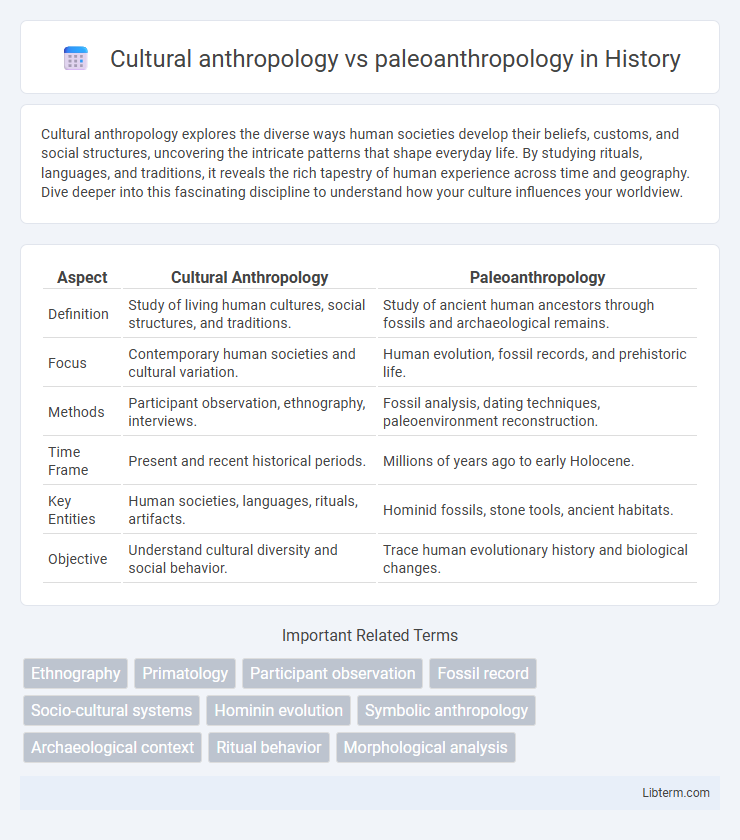Cultural anthropology explores the diverse ways human societies develop their beliefs, customs, and social structures, uncovering the intricate patterns that shape everyday life. By studying rituals, languages, and traditions, it reveals the rich tapestry of human experience across time and geography. Dive deeper into this fascinating discipline to understand how your culture influences your worldview.
Table of Comparison
| Aspect | Cultural Anthropology | Paleoanthropology |
|---|---|---|
| Definition | Study of living human cultures, social structures, and traditions. | Study of ancient human ancestors through fossils and archaeological remains. |
| Focus | Contemporary human societies and cultural variation. | Human evolution, fossil records, and prehistoric life. |
| Methods | Participant observation, ethnography, interviews. | Fossil analysis, dating techniques, paleoenvironment reconstruction. |
| Time Frame | Present and recent historical periods. | Millions of years ago to early Holocene. |
| Key Entities | Human societies, languages, rituals, artifacts. | Hominid fossils, stone tools, ancient habitats. |
| Objective | Understand cultural diversity and social behavior. | Trace human evolutionary history and biological changes. |
Definition of Cultural Anthropology
Cultural anthropology is the scientific study of human societies, cultures, and their development, emphasizing social practices, beliefs, and institutions. It investigates how cultural norms shape human behavior and social interaction across diverse communities. Unlike paleoanthropology, which focuses on human evolution and fossil records, cultural anthropology concentrates on contemporary and historical cultural patterns.
Definition of Paleoanthropology
Paleoanthropology is the scientific study of ancient humans and their evolutionary ancestors through fossil evidence and archaeological findings, emphasizing biological and cultural development over millions of years. It integrates disciplines like geology, biology, and archaeology to reconstruct human origins, physical characteristics, and adaptation processes. Unlike cultural anthropology, which examines contemporary human societies and cultures, paleoanthropology focuses primarily on prehistoric periods and evolutionary history.
Historical Development of Both Fields
Cultural anthropology emerged in the late 19th century with pioneers like Franz Boas emphasizing the study of contemporary human societies and cultural diversity, while paleoanthropology developed as a distinct discipline through discoveries of early hominid fossils in the early 20th century, notably with Raymond Dart's identification of Australopithecus africanus. Both fields evolved through advancements in archaeological methods and scientific techniques, with cultural anthropology focusing on ethnographic research and paleoanthropology on fossil analysis and evolutionary history. The parallel growth of these disciplines reflects their complementary roles in understanding human history, culture, and biological evolution.
Key Research Methods in Cultural Anthropology
Ethnographic fieldwork and participant observation are central research methods in cultural anthropology, allowing in-depth study of living societies and their social practices. Interviews, surveys, and analysis of cultural artifacts help anthropologists understand language, rituals, kinship systems, and belief structures. These qualitative techniques contrast with paleoanthropology's focus on fossil analysis, comparative anatomy, and dating methods to study human evolution.
Key Research Methods in Paleoanthropology
Paleoanthropology employs methods such as fossil excavation, stratigraphic analysis, and radiometric dating to uncover and date ancient human remains and artifacts. Comparative anatomy and 3D imaging techniques help reconstruct hominin morphology and evolutionary relationships. These scientific approaches contrast with the ethnographic fieldwork and participant observation used in cultural anthropology.
Areas of Focus: Culture vs. Human Evolution
Cultural anthropology examines human societies, customs, beliefs, and social behaviors, emphasizing how culture shapes human experience and interaction. Paleoanthropology focuses on the biological and evolutionary aspects of humans, studying fossil records and physical traits to trace human origins and development over millions of years. While cultural anthropology explores contemporary and historical human cultures, paleoanthropology investigates prehistoric human evolution and anatomical changes.
Notable Discoveries and Case Studies
Cultural anthropology has uncovered significant insights into human societies through case studies like Bronislaw Malinowski's analysis of the Trobriand Islanders, revealing complex kinship and exchange systems. Paleoanthropology's notable discoveries include the unearthing of the "Lucy" fossil (Australopithecus afarensis) in Ethiopia, providing critical evidence for bipedalism in early hominins. Both fields contribute uniquely to understanding human evolution, culture, and adaptation through distinct empirical methods and landmark findings.
Influential Figures in Both Disciplines
Franz Boas, known as the father of American cultural anthropology, revolutionized the field with his emphasis on cultural relativism and empirical fieldwork. In paleoanthropology, figures like Raymond Dart and Donald Johanson made groundbreaking discoveries, such as the Taung Child and the famous Australopithecus afarensis fossil "Lucy," which reshaped understanding of human evolution. Both disciplines owe much to these pioneers for establishing foundational methodologies and expanding knowledge of human origins and cultural diversity.
Interdisciplinary Connections and Overlaps
Cultural anthropology and paleoanthropology intersect through their shared focus on human origins and societal development, employing archaeological findings and biological data to reconstruct past behaviors and cultural evolution. Both disciplines integrate methods from genetics, linguistics, and ecology to provide a comprehensive understanding of human adaptation and diversity. Cross-disciplinary research enhances insights into the relationship between ancient environments, cultural practices, and evolutionary processes shaping modern human populations.
Future Directions in Anthropological Research
Cultural anthropology and paleoanthropology are increasingly integrating advanced technologies such as AI and genomics to uncover complex human behaviors and evolutionary patterns. Future research will emphasize interdisciplinary collaboration, combining ethnographic methods with archaeological data to explore cultural adaptations and cognitive evolution. Emphasis on environmental change and biocultural interactions will drive innovative approaches in understanding human diversity and resilience across time.
Cultural anthropology Infographic

 libterm.com
libterm.com